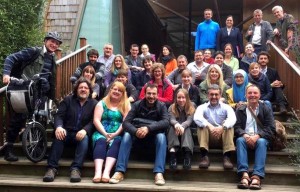Have you tried Dr M’s spot test from the BES/EFL workshop in Hyde Park? If not check it out here have a go then come back for the answers!
- 01
- 02
- 03
- 04
- 05
- 06
- 07
- 08
- 09
- 10
- 11
- 12
- 13
- 14
- 15
Check the pictures against the answers below, give yourself 2 marks if you got the answer correct.
If you didn’t quite get the answer correct but were part way there you can still get a mark, so, for example, if you thought #2 was a rush but didn’t know it was soft rush you can still score 1 mark. This may sound generous but then Dr M is famed for his botanical generosity!
So, how did you do?
But when all is said and done marks are just marks, the real result is how much you recall in the future and how much you are spurred on to learn more and more on your extreme botanical journey!
(Scroll down to see how the participants at BES/EFL workshop did).
| Family | Latin name | Common name | # Correct | % | |
| 1 | Dipsacaceae | Dipsacus fullonum | Teasel | 20 | 91% |
| 2 | Juncaceae | Juncus effusus | Soft rush | 1 | 5% |
| 3 | Poaceae | Phleum pratense | Timothy | 2 | 9% |
| 4 | Sapindaceae | Acer pseudoplatanus | Sycamore | 14 | 64% |
| 5 | Fagaceae | Quercus robur | Common oak | 21 | 95% |
| 6 | Ranunculaceae | Clematis vitalba | Old mans beard | 14 | 64% |
| 7 | Urticaceae | Urtica dioica | Stinging Nettle | 14 | 64% |
| 7 | Taxaceae | Taxus baccata | Yew | 20 | 91% |
| 8 | Onagraceae | Chamerion angustifolium | Rosebay willow | 15 | 68% |
| 10 | Hydrocharitaceae | Stratiotes aloides | Water soldier | 7 | 32% |
| 11 | Poaceae | Phragmites australis | Common reed | 8 | 36% |
| 12 | Lamiaceae | Mentha aquatica | Water mint | 5 | 23% |
| 13 | Scrophulariaceae | Buddleia davidii | Buddleia | 19 | 86% |
| 14 | Lamiaceae | Origanum vulgare | Marjoram | 6 | 27% |
| 15 | Cyperaceae | Carex pendula | Pendulous sedge | 0 | 0% |
And so how did they do?
Well, at the BES/EFL workshop the audience was by no means replete with botanists but consisted of a variety of disciplines including earth scientists, geographers, zoologists as well as a few botanists, so Dr M was interested to see how they all fared in this spot test!
Twenty-two participants completed the spot test and no-one got a zero score, so everyone in the group got something right, and many people got quite a lot right.
The average score was 50% with a wide range from 7% (one correct answer) to 80% (12 correct answers).
But as Dr M tells his students, with plant ID it is rarely a simple matter of right or wrong and there are many ways to be close to a correct answer, and these partially correct answers are valid too.
So some participants may not have got the correct species but nonetheless got the correct family or genus, for example five participants ID’d the Water Mint but a further twelve recognised it as a mint (from the scent of the plant no doubt) but not exactly Water Mint.
So, if we take these partially correct answers into account then the average goes up to 71% with the range 7%-100%,there was clearly a lot of general as well as specific plant knowledge in the room!
More than half the participants recognised eight common plants: Pedunculate Oak, Yew, Teasel, Buddleia (non-native invasive species, much loved by butterflies), Rosebay Willowherb, Stinging Nettle, Old Man’s Beard and Sycamore (though some mistook Sycamore with its opposite leaf pairs, for London Plane which is abundant in Hyde Park but which has alternate leaves).
Less familiar were the famously tricky groups the grasses, rushes and sedges – poor old Pendulous Sedge got not a single correct answer! However, nine participants realised it was a sedge! (41%).
Water Soldier was new to many of the participants and is an increasingly uncommon plant in Britain, actually it’s probably non-native in Britain and all our plants are female, reproducing vegetatively. and it makes a nice feature of the pond at the Isis Centre.
Dr M says: “I was delighted to see participants adding notes about the plants’ uses, history and cultural uses (ethnobotany), this reminds us that botany is not just about the naming of plants but also about understanding plants in their natural and human context.”
“Examples were the acorns of Oaks used as pig food and coffee substitute, Yew contains anti-cancer compounds and for making longbows and for wood turning, Nettles good for making tea and soup and also as a wrap for Cornish Yarg, Mint (and a lot of other Lamiaceae) yield essential oils while Teasel seeds are devoured by Goldfinches and the teasel head has been used for teasing wool and other yarns and of course the Dipsacaceous teasel head is famously Mrs Tiggy Winkle’s hairbrush!”

















